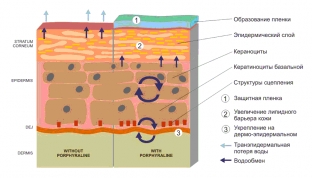Chemical facial peels or laser skin resurfacing procedures are performed with the expected damage to some layers of the skin, which causes a controlled inflammatory response, which is necessary for further renewal processes. During this period, it is important to choose a skin care regimen for the patient that will quickly restore its barrier functions and accelerate healing. What skin reactions after peeling should be expected and how to level them, read on estet-portal.com.
Possible Expected Reactions After a Chemical Facial Peel
Immediate reactions that develop in the first hours and days after a chemical facial peel are to be expected. They arise due to the fact that the integrity of the epidermis is broken, and are caused by the inflammatory process in the skin. These expected responses include:
- dehydration – moisture loss occurs due to damage to the stratum corneum or its removal during the procedure;
- erythema – uneven and moderately intense occurs in the first 1-3 hours after facial peeling with alpha-hydroxy acids, bright and uniform for 1-2 days after peeling with resorcinol or trichloroacetic acid (less than 15%), bright and persistent for 3-5 days after retinoic or median TCA peel (acid concentration 25-30%);
- flaking – microplate 1-3 days after peeling with fruit acids, large-plate 2-7 days after peeling with resorcinol, retinoids, trichloroacetic and salicylic acids;
- puffiness – due to the release of pro-inflammatory mediators and an increase in the permeability of the vascular walls, rarely occurs after superficial peeling, after peeling with retinoids and acids no higher than 15% is noticeable in areas of the face with thin skin, inevitable after median TCA facial peels;
- skin darkening – happens after acid-enzyme facial peels, often observed in patients & nbsp; with IV-V skin phototype.
In order to reduce the intensity of expected reactions after facial peeling, it is necessary to build a post-treatment care program so that the skin receives everything it needs to restore the epidermal barrier and replenish water reserves.
How to take care of skin damaged by a chemical facial peel
For normal skin recovery and epithelialization after peeling, it is necessary to provide active hydration of the epidermis. This measure, in addition to leveling the patient's discomfort associated with a feeling of tightness of the skin after the procedure, will reduce the risk of scarring after peeling and accelerate normal epithelialization, reduce skin hypersensitivity.
The best moisturizing effect after facial peeling is achieved by using hyaluronic acid and components of the natural moisturizing factor – urea, amino acids, proteins, sodium and calcium ions.

Cosmetic products that contain phospholipids, ceramides, omega acids, as well as those that include shea butter, grape seed oil.
After more serious damaging procedures - medium and deep peelings, cosmetic products that stimulate tissue regeneration and accelerate healing processes must be included in the skin care regimen. These are products with panthenol, bisabolol, retinol.
To reduce the risk of post-peeling pigmentation and reduce the severity of the inflammatory reaction, it is recommended to use cosmetic products with antioxidants – selenium, tocopherol, ubiquinone.
In the first days after facial peeling, when the skin is still very inflamed, it is most convenient to use cosmetic skin care products in the form of foam or gel. They are easily and quickly absorbed, without requiring rubbing. Approximately from the third day after the procedure, when the active process of skin peeling begins, it is preferable to use creams in care.







Add a comment